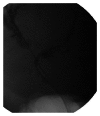Safety and efficacy of radiofrequency ablation in the management of unresectable bile duct and pancreatic cancer: a novel palliation technique
- PMID: 23690775
- PMCID: PMC3649248
- DOI: 10.1155/2013/910897
Safety and efficacy of radiofrequency ablation in the management of unresectable bile duct and pancreatic cancer: a novel palliation technique
Abstract
Objectives. Radiofrequency ablation (RFA) has replaced photodynamic therapy for premalignant and malignant lesions of the esophagus. However, there is limited experience in the bile duct. The objective of this pilot study was to assess the safety and efficacy of RFA in malignant biliary strictures.
Methods: Twenty patients with unresectable malignant biliary strictures underwent RFA with stenting between June 2010 and July 2012. Diameters of the stricture before and after RFA, immediate and 30 day complications and stent patency were recorded prospectively. Results. A total of 25 strictures were treated. Mean stricture length treated was 15.2 mm (SD = 8.7 mm, Range = 3.5-33 mm). Mean stricture diameter before RFA was 1.7 mm (SD = 0.9 mm, Range = 0.5-3.4 mm) while the mean diameter after RFA was 5.2 mm (SD = 2 mm, Range = 2.6-9 mm). There was a significant increase of 3.5 mm (t = 10.8, DF = 24, P value = <.0001) in the bile duct diameter post RFA. Five patients presented with pain after the procedure, but only one developed mild post-ERCP pancreatitis and cholecystitis.
Conclusions: Radiofrequency ablation can be a safe palliation option for unresectable malignant biliary strictures. A multicenter randomized controlled trial is required to confirm the long term benefits of RFA and stenting compared to stenting alone.
Figures





References
-
- Shepherd HA, Royle G, Ross APR, Diba A, Arthur M, Colin-Jones D. Endoscopic biliary endoprosthesis in the palliation of malignant obstruction of the distal common bile duct: a randomized trial. British Journal of Surgery. 1988;75(12):1166–1168. - PubMed
-
- Davids PHP, Groen AK, Rauws EAJ, Tytgat GNJ, Huibregtse K. Randomised trial of self-expanding metal stents versus polyethylene stents for distal malignant biliary obstruction. The Lancet. 1992;340(8834-8835):1488–1492. - PubMed
-
- Rossi P, Bezzi M, Rossi M, et al. Metallic stents in malignant biliary obstruction: results of a multicenter European study of 240 patients. Journal of Vascular and Interventional Radiology. 1994;5(2):279–285. - PubMed
Grants and funding
LinkOut - more resources
Full Text Sources
Other Literature Sources
Medical
Miscellaneous

